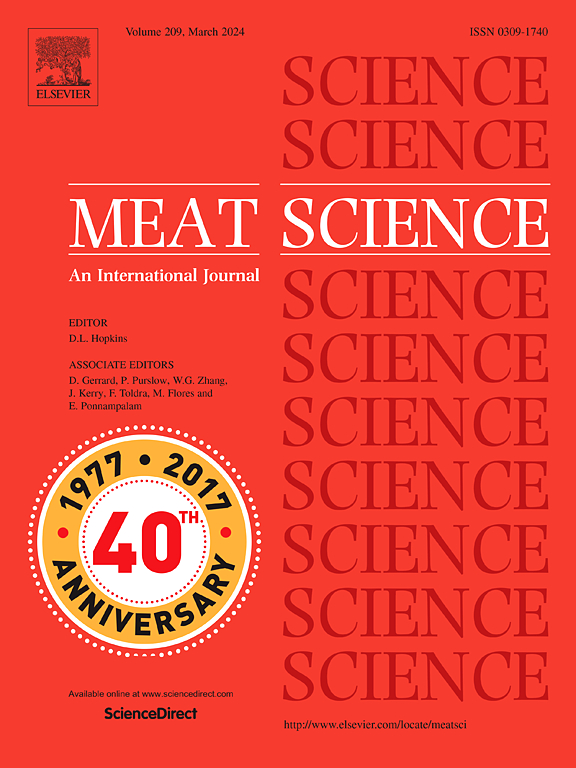Assessing how the partial substitution of phosphate by modified chickpea protein affects the technofunctional, rheological, and structural characteristics of pork meat emulsions
IF 7.1
1区 农林科学
Q1 Agricultural and Biological Sciences
引用次数: 0
Abstract
The effects of high-pressure homogenization (HPH, 80 MPa, two cycles) and/or heat-treatment (80 °C, 30 min) modified chickpea protein (CP) on water- and fat-binding capacities, texture, color, and flavor attributes of reduced-phosphate (0.2 % sodium tripolyphosphate, STPP, w/w) pork meat emulsions (RPMEs) were evaluated. The results showed that either HPH or heat-treatment modified CP exhibited a considerable improvement in emulsion stability, textural attributes (hardness, cohesiveness, and chewiness), and b⁎ values (P < 0.05), promoted the formation of inorganic and organic sulfide compounds, and enhanced the umami, richness, and saltiness of RPMEs. Moreover, HPH + heat-treatment dual–modified CP showed superior enhancement effects on most technofunctional properties, thereby imparting the meat emulsion with quality characteristics comparable with high-phosphate control (0.4 % STPP, w/w). Hierarchical cluster analysis and partial least squares regression analysis suggested that the changes in technofunctional traits of RPMEs containing modified CP could be associated with rheological and structural modifications in meat emulsions. Theses alterations included enhanced viscoelasticity, elevated stabilization of internal water, reinforced aliphatic-residue hydrophobic interactions, strengthened intermolecular hydrogen and disulfide bonding, the uncoiling of α-helices concurrent with the formation of β-sheets and random coils, and an increased fractal dimension and decreased porosity of the gel networks. Therefore, HPH combined with heat-treatment modified CP is an intriguing phosphate substitute for developing reduced-phosphate meat products.
评价改性鹰嘴豆蛋白部分取代磷酸盐对猪肉乳剂的技术功能、流变学和结构特性的影响
研究了高压均质(高压,80 MPa,两个循环)和/或热处理(80℃,30 min)改性鹰嘴豆蛋白(CP)对降磷酸(0.2%三聚磷酸钠,STPP, w/w)猪肉乳剂(RPMEs)的水和脂肪结合能力、质地、颜色和风味特性的影响。结果表明,HPH或热处理改性CP在乳状液稳定性、结构属性(硬度、黏结性和咀嚼性)和b β值(P <;0.05),促进了无机和有机硫化物的形成,增强了rpme的鲜味、丰富度和咸味。此外,HPH +热处理双改性CP对大多数技术功能性能都有较好的增强效果,从而使肉乳具有与高磷酸盐对照(0.4% STPP, w/w)相当的品质特性。分层聚类分析和偏最小二乘回归分析表明,含改性CP的RPMEs技术功能性状的变化可能与肉乳剂的流变学和结构变化有关。这些变化包括粘弹性增强,内部水稳定性提高,脂肪-残基疏水相互作用增强,分子间氢和二硫键增强,α-螺旋展开同时形成β-片和随机线圈,分形维数增加,孔隙率降低。因此,HPH结合热处理改性CP是一种很有前途的磷酸盐替代品,可用于开发低磷肉制品。
本文章由计算机程序翻译,如有差异,请以英文原文为准。
求助全文
约1分钟内获得全文
求助全文
来源期刊

Meat Science
工程技术-食品科技
CiteScore
12.60
自引率
9.90%
发文量
282
审稿时长
60 days
期刊介绍:
The aim of Meat Science is to serve as a suitable platform for the dissemination of interdisciplinary and international knowledge on all factors influencing the properties of meat. While the journal primarily focuses on the flesh of mammals, contributions related to poultry will be considered if they enhance the overall understanding of the relationship between muscle nature and meat quality post mortem. Additionally, papers on large birds (e.g., emus, ostriches) as well as wild-captured mammals and crocodiles will be welcomed.
 求助内容:
求助内容: 应助结果提醒方式:
应助结果提醒方式:


